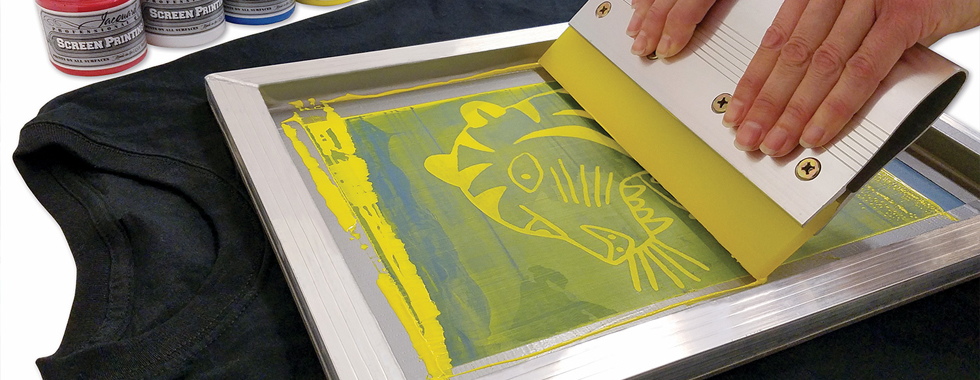The Important Overview to Recognizing Screen Printing and Its Versatile Makes use of
Screen printing has an abundant history that goes back to ancient times, developing into an advanced strategy made use of across different industries today. This overview discovers the complexities of the screen printing process, outlining its applications in style, marketing, and home design - 10:9 Design Texas. Understanding these basics can open imaginative potential for both creative and commercial projects. The complying with sections will certainly disclose necessary ideas and methods to enhance one's screen printing undertakings
The Background of Screen Printing
Screen printing has roots that trace back centuries, its evolution reflects the technological and artistic developments of various societies. Coming from ancient China, the method was initially utilized for embellishing fabrics and later spread to Japan, where it ended up being integral to Ukiyo-e woodblock printing. The method shifted to Europe in the 18th century, where it got popularity among artisans and commercial printers. The invention of image emulsion in the 20th century revolutionized screen printing, allowing for even more complex layouts and greater performance. Artists like Andy Warhol further drove its popularity, utilizing the medium to create renowned jobs that blended commercialism and art. By the late 20th century, screen printing had established itself as a versatile method, utilized in style, marketing, and art. Today, it continues to progress, incorporating electronic innovation and broadening its applications throughout different markets.
The Screen Printing Process Explained
Screen printing changes imaginative visions into concrete layouts with a collection of accurate steps. An image is developed and after that transferred onto a screen, generally made of fine mesh material extended over a structure. A light-sensitive emulsion is applied to the screen, which is subjected to light, hardening in locations not covered by the photo. After cleaning out the unhardened solution, a pattern is developed.
Next off, the screen is put over the substratum, whether it be textile, paper, or another product. Ink is then pushed with the open areas of the stencil making use of a squeegee, depositing the design onto the substrate listed below. This process can be duplicated for several colors, needing separate screens for each tone. The published product is cured making use of warm to assure the ink adheres properly, resulting in a resilient, vivid layout all set for use.
Sorts Of Screen Printing Techniques

In addition, specialized strategies, such as discharge screen printing, remove color from the textile to create softer prints, while foil screen printing applies metal aluminum foil to achieve a shiny finish (10:9 Design LLC Company). Each technique provides distinct features, accommodating various creative demands and manufacturing ranges, eventually increasing the opportunities within the screen printing domain name
Applications of Screen Printing in Different Industries

Additionally, the signage and advertising and marketing markets page use screen printing for creating appealing screens and banners. This approach enables for bold colors and detailed styles that record focus. In electronics, screen printing is used for applying conductive inks to circuit card, important for element links. The home design market accepts screen printing to create distinct designs on textiles and wall surface art. Generally, screen printing acts as an essential tool across diverse areas, enhancing products with customized and aesthetically appealing graphics.
Tips for Successful Screen Printing Projects
While taking on a screen printing job, careful interest to information can significantly improve the final outcome. Initially, selecting high-grade materials is important; this consists of the screen, inks, and substrates. Making use of proper mesh matters can impact ink deposition and information resolution. Prep work is similarly essential; complete cleaning of displays and correct direct exposure times assure crisp prints.
Next, exact enrollment is important for multi-color prints. Making use of alignment tools can help achieve precise layering. Furthermore, screening prints on scrap products prior to production assists identify potential concerns without squandering sources.

Often Asked Inquiries
What Products Are Finest for Screen Printing on Textile?
Cotton and polyester blends are ideal for screen printing on textile due to their longevity and ink absorption. Additionally, specialized fabrics like silk or canvas can generate unique appearances and coatings, enhancing the general design high quality.
How Do I Tidy and Maintain Screen Printing Devices?
To maintain and clean up screen printing devices, one ought to on a regular basis clean screens with ideal solvents, evaluate squeegees for wear, lubricate relocating parts, and shop all products in a completely dry, dust-free environment to lengthen their lifespan.
What Are the Ecological Impacts of Screen Printing?
Screen printing can have substantial environmental effects, consisting of chemical waste from inks and solvents, water use throughout cleaning procedures, and energy intake. Lasting practices and eco-friendly products are necessary for lessening these unfavorable effects.
Can Screen Printing Be Done at Home Properly?
Screen printing can be effectively done at home look here with the appropriate products and techniques. Enthusiasts can create quality prints, though success depends on their ability degree, devices, and understanding of the process included.
What Are the Expenses Associated With Starting a Screen Printing Company?

Starting a screen printing business involves prices for equipment, materials, and workspace. Initial expenses generally vary from a couple of hundred to several thousand dollars, depending on the scale, quality of equipment, and wanted manufacturing ability.
Screen printing has an abundant history that dates back to ancient times, progressing into a sophisticated technique made use of throughout various markets today. An additional strategy, rotary screen printing, employs cylindrical displays, assisting in continuous printing on material rolls, thus enhancing efficiency for large manufacturings. Additionally, specialized methods, such as discharge screen printing, get rid of color from the fabric to develop softer prints, while foil screen printing uses metal aluminum foil to achieve a glossy coating. In the style market, screen printing is widely made use of to produce vivid styles on apparel, enabling brands to showcase their unique designs. Cotton and polyester blends are perfect for screen printing on textile due to their sturdiness and ink absorption.